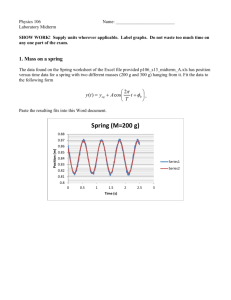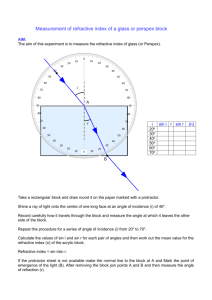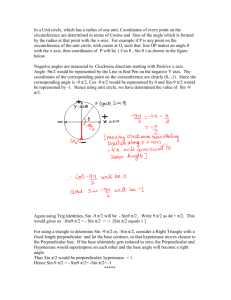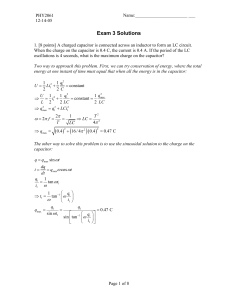exam3_2012solutions
advertisement
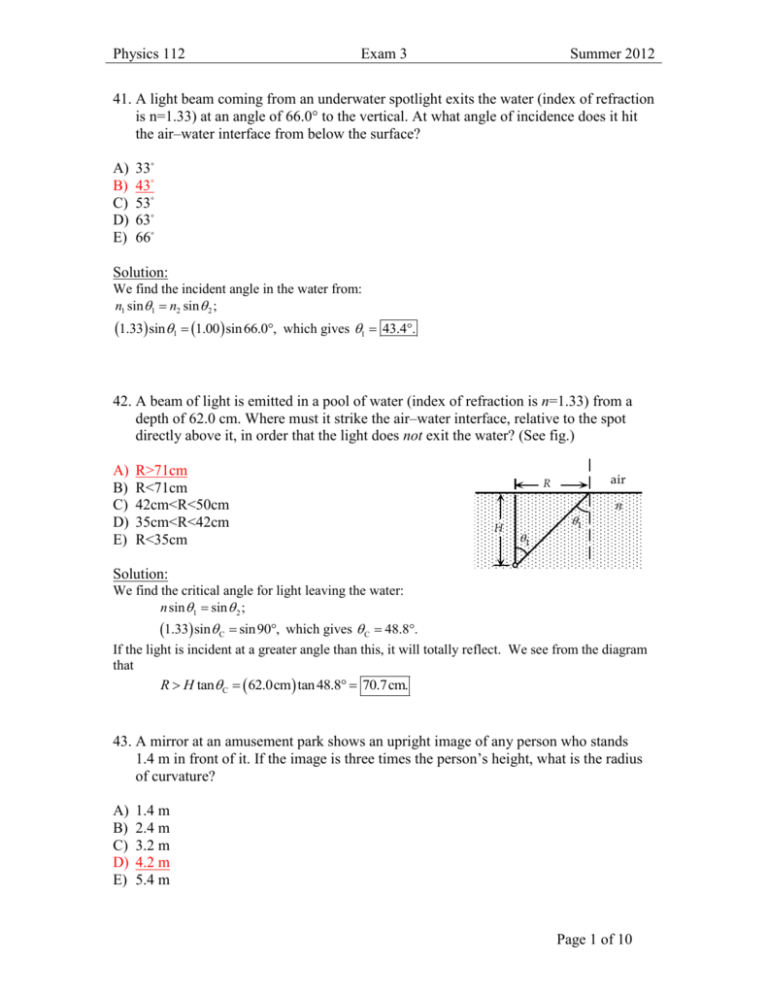
Physics 112 Exam 3 Summer 2012 41. A light beam coming from an underwater spotlight exits the water (index of refraction is n=1.33) at an angle of 66.0° to the vertical. At what angle of incidence does it hit the air–water interface from below the surface? A) B) C) D) E) 33◦ 43◦ 53◦ 63◦ 66◦ Solution: We find the incident angle in the water from: n1 sin 1 n2 sin 2 ; 1.33 sin1 sin 66.0, which gives 1 43.4. 42. A beam of light is emitted in a pool of water (index of refraction is n=1.33) from a depth of 62.0 cm. Where must it strike the air–water interface, relative to the spot directly above it, in order that the light does not exit the water? (See fig.) A) B) C) D) E) R>71cm R<71cm 42cm<R<50cm 35cm<R<42cm R<35cm air R H 1 1 n Solution: We find the critical angle for light leaving the water: n sin 1 sin 2 ; 1.33 sin C sin 90, which gives C 48.8. If the light is incident at a greater angle than this, it will totally reflect. We see from the diagram that R H tan C 62.0cm tan 48.8 70.7cm. 43. A mirror at an amusement park shows an upright image of any person who stands 1.4 m in front of it. If the image is three times the person’s height, what is the radius of curvature? A) B) C) D) E) 1.4 m 2.4 m 3.2 m 4.2 m 5.4 m Page 1 of 10 Physics 112 Exam 3 Summer 2012 Solution: We find the image distance from the magnification: h d m i i ; ho do di 3 , which gives di 4.2 m. 1.4 m We find the focal length from 1 1 1 1 1 1 , which gives f 2.1m. ; 1.4 m 4.2 m f d o di f The radius of the concave mirror is r 2 f 2 2.1m 4.2m. 44. Convex spherical mirrors produce images which are A) B) C) D) E) always real and smaller than the actual object always virtual and smaller than the actual object always real and larger than the actual object always virtual and larger than the actual object could be real or virtual and larger or smaller than the actual object, depending on the placement of the object 45. An object is placed between a convex lens and its focal point. The image formed is A) B) C) D) E) virtual and erect virtual and inverted real and erect real and inverted could be real or virtual and erect or inverted 46. A convex lens has a focal length f. An object is placed between f and 2f on the axis. The image formed is located A) B) C) D) E) at 2f between f and 2f at f at a distance greater than 2f from the lens at a distance smaller than f Page 2 of 10 Physics 112 Exam 3 Summer 2012 47. A 4.5-cm-tall object is placed 28 cm in front of a spherical mirror. It is desired to produce a virtual image that is upright and 3.5 cm tall. What is the focal length of the mirror? A) B) C) D) E) -38 cm -68 cm -98 cm 68 cm 98 cm Solution: (a) To produce a smaller image located behind the surface of the mirror requires a convex mirror. (b) We find the image distance from the magnification: m hi di ; ho do 3.5cm di , which gives 4.5cm 28cm di 21.8cm. As expected, di 0. The image is located 22 cm behind the surface. (c) We find the focal length from 1 1 1 ; d o di f 1 1 1 , which gives f 98cm. 28cm 21.8cm f 48. A parallel beam of light from a He-Ne laser, with a wavelength 656 nm, falls on two very narrow slits 0.060 mm apart. How far apart are the fringes in the center of the pattern on a screen 3.6 m away? A) B) C) D) E) 0.2 cm 0.6 cm 1.7 cm 2.8 cm 3.9 cm Solution: For constructive interference, the path difference is a multiple of the wavelength: d sin m , m 0, 1, 2, 3, ... . We find the location on the screen from Page 3 of 10 Physics 112 Exam 3 Summer 2012 y L tan . For small angles, we have sin tan , which gives m mL y L . d d For adjacent fringes, m 1, so we have y 3.6 m 656 109 m 1 L m 3.9 102 m 3.9 cm. ; 3 d 0.060 10 m 49. In a double-slit experiment, it is observed that the distance between adjacent maxima on a remote screen is 1.0 cm. What happens to the distance between adjacent maxima when the slit separation is cut in half? A) B) C) D) E) It increases to 2.0 cm. It increases to 4.0 cm. It increases to 8.0 cm. It decreases to 0.50 cm. It decreases to 0.25 cm. Solution: m yx d 50. When violet light of wavelength 415 nm falls on a single slit, it creates a central diffraction peak that is 9.20 cm wide on a screen that is 2.55 m away. How wide is the slit? A) B) C) D) E) 23 cm 2.3 cm 5.2 mm 5.2m 23m Solution: We find the angle to the first minimum from the distances: 9.20cm 0.0180 sin , because the angle is small. tan1min 12 1min 255cm We find the slit width from D sin 1min m ; D 0.0180 1 415 109 m , which gives D 2.30 105 m 0.0230mm. Page 4 of 10 Physics 112 Exam 3 Summer 2012 51. Which color of visible light would give the best resolution in a microscope? A) B) C) D) E) Red Yellow Green Blue All colors give the same resolution Solution: To get the best resolution from a microscope, you should use blue/violet light. The Rayleigh criterion 1.22 shows that the shorter wavelengths of light have higher resolution. (Of D course, you would need very special lenses, since most glass absorbs blue/violet light very strongly.) 52. The first-order line of 589-nm light falling on a diffraction grating is observed at a 15.5° angle. At what angle will the third order be observed? A) B) C) D) E) 31.0° 46.5° 53.3° 62.1° 71.4° Solution: sin m sin 3 3 m d sin 1 1 sin 3 3 sin 1 3 sin 15.5 0.8017 3 53.3 53. A lens appears greenish yellow ( 570 nm is strongest) when white light reflects from it. What minimum thickness of coating (n 1.25) do you think is used on such a glass (n 1.52) lens, and why? A) B) C) D) E) 152 nm 228 nm 320 nm 440 nm 570 nm Solution: The total phase shift is zero. For constructive interference: 2t m film m n . The minimum non-zero thickness occurs for m 1: 570nm 228nm. tmin 2nfilm 2 1.25 Page 5 of 10 Physics 112 Exam 3 Summer 2012 54. What is Brewster’s angle for an air–glass (n 1.52) surface? A) B) C) D) E) 31.2° 41.0° 45.0° 48.1° 56.7° Solution: Because the light is coming from air to glass, we find the angle from the vertical from tan p nglass 1.52, which gives p 56.7. 1 55. A light meter reports that a camera setting of 200 s at f 8 will give a correct exposure. But the photographer wishes to use f 16 to increase the depth of field. What should the shutter speed be (time shutter is open)? A) B) C) D) E) (1/50)s (1/100)s (1/200)s (1/400)s (1/800)s Solution: f D8 f D ' 16 t 1 / 200 s 2 2 2 f ' D' D D' 1 1 16 t t ' t ' t s s 50 200 8 f f ' f D 2 56. What statement is wrong? A) B) C) D) E) Far point is farthest distance at which object can be seen clearly. Normal far point is about 25 cm. Nearsightedness means that far point is too close. Near point is closest distance at which eye can focus clearly. Farsightedness means near point is too far away. Solution: Normal FP is at infinity. Normal NP is about 25 cm. Page 6 of 10 Physics 112 Exam 3 Summer 2012 57. Reading glasses of what power are needed for a person whose near point is 115 cm, so that he can read a computer screen at 55 cm? Assume a lens–eye distance of 1.8cm. A) B) C) D) E) -1D -2D +1D +2D +3D Solution: With the lens, the screen placed 55 cm from the eye, or 53.2 cm from the lens, is to produce a virtual image 115 cm from the eye, or 113.2 cm from the lens. We find the power of the lens from 1 1 1 P, when distances are in m; d o di f 1 1 P 1.0D. 0.532m 1.132m 58. A small insect is placed 5.00 cm from a 6.00 -cm-focal-length lens. Calculate the angular magnification. A) B) C) D) E) 2 3 4 5 6 Solution: ' 25cm 25cm M 5.00 d0 5.00cm 59. An astronomical telescope has an objective with focal length 85 cm and a 35-D eyepiece. What is the total magnification? A) B) C) D) E) -17 +17 -30 +30 -33 Solution: f M 0 f 0 Pe ; fe M 0.85m 35m 1 30 . Page 7 of 10 Physics 112 Exam 3 Summer 2012 60. A microscope has a 1.8-cm-focal-length eyepiece and a 0.85-cm objective lens. The distance between the lenses is 16.0 cm. Calculate the total magnification (ignore minus sign). A) B) C) D) E) 55 83 110 150 232 Solution 25cm l f e M f e d 0 25cm 16cm 1.8cm 232 1.8cm 0.85cm 41-23.28 42-23.38 43-23.10 44-L18 45-L19 46-L19 47-23.21 (hw10) 48-24.4 49-L20 50-24-24 51-Q25.17 52-24.31 53-24.42 54-24.54 55-25.3 (modified) 56-L23 (modified) 57-25.12 58-25.26 59-25.26b 60-25.43b (hw13) Page 8 of 10 Physics 112 Exam 3 Summer 2012 #39. A beam of light is emitted 8.0 cm beneath the surface of a liquid and strikes the surface 7.0 cm from the point directly above the source. If total internal reflection occurs, what can you say about the index of refraction of the liquid? Solution: We find the angle of incidence from the distances: L 7.0cm tan 1 0.875, so 1 41.2. h 8.0cm For the maximum incident angle for the refraction from liquid into air, we have nliquid sin1 nair sin 2 ; nliquid sin 1max 1.00 sin 90, which gives sin 1max 1 nliquid . Thus we have sin 1 sin 1max 1 ; nliquid sin 41.2 0.659 1 nliquid , or nliquid 1.5. Page 9 of 10 Physics 112 Exam 3 Summer 2012 Record Sheet 41 B) 43◦ 51 D) Blue 42 A) R>71 cm 52 C) 53.3° 43 D) 4.2 m 53 B) 228 nm 44 B) always virtual and smaller than the actual object 54 E) 56.7° 45 A) virtual and erect 55 A) (1/50)s 46 D) at a distance greater than 2f from the lens 56 B) Normal far point is about 25 cm 47 C) -98 cm 57 C) +1D 48 E) 3.9 cm 58 D) 5 49 A) It increases to 2.0 cm. 59 C) -30 50 E) 23m 60 E) 232 Page 10 of 10

